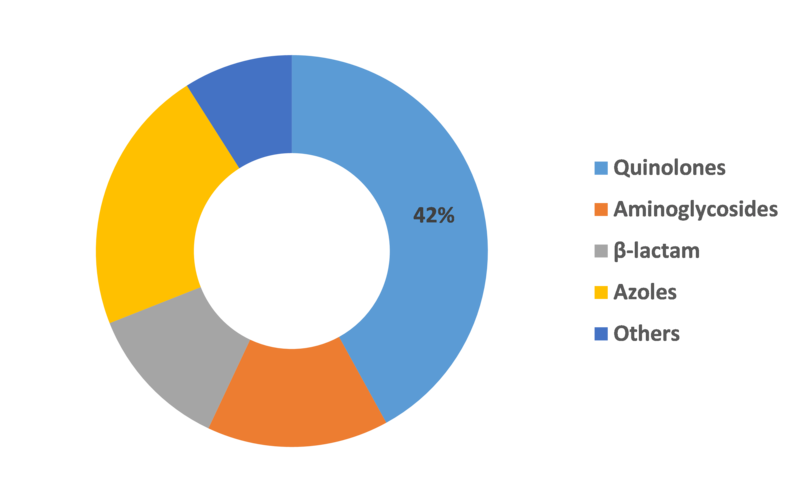Market Analysis
The global urinary tract infection market is poised to surpass USD 9.89 billion at a significant 3.6% CAGR over the estimated years (2017-2023). UTI or urinary tract infection is an infection occurring in the upper or lower urinary tract including the urethra and the bladder. UTIs are of two types – urethritis and cystitis. The former is an infection that is takes place in the urethra while the latter is an infection that takes place in the bladder. Getting this infection is easy. Bacteria that lives in the genital, vagina and anal areas can enter the urethra and travel the bladder thereby causing infection. The common symptoms related to UTI include burning and painful sensation while urinating and frequent, strong urge to urinate. The primary causes of urinary tract infection include obesity, diabetes, bowel incontinence, poor personal hygiene, sexual intercourse, enlarged prostate gland and blockage in the urinary tract mainly kidney stone.
Get Free Sample of This Report @ https://www.marketresearchfuture.com/sample_request/6138
There are abundant factors that is propelling the growth of the urinary tract infection market. These factors as per the MRFR (Market Research Future) report include increase in hospital-borne infections, rising geriatric population, emergence of drug-resistant bacteria, rising health awareness amid women, increase in diagnosis, prevalence rate of diseases mainly kidney stone and diabetes, increasing incidences of UTI, changing lifestyle pattern, favorable reimbursement policies and higher treatment compliance. On the contrary, increasing market fragmentation, loss of patents, unmet clinical needs, growing drug resistance, lack of awareness amid people, strict government regulations, adverse effects of medications, poor patient compliance and generic erosion are factors that may restrict urinary tract infection market growth.
Market Segmentation
MRFR report offers a broad segmental analysis of the urinary tract infection market on the basis of drug class, clinical indications and end users.
Based on drug class, it is segmented into azoles, β-lactam, aminoglycosides, quinolones and others.
Based on clinical indications, the urinary tract infection market is segmented into pyelonephritis, cystitis, urethritis and others.
Based on end users, it is segmented into self-administered, hospitals and others.
Regional Analysis
By region, the urinary tract infection market covers growth opportunities and latest trends across North America, Europe, Asia Pacific, and Middle East and Africa. Of these, North America will stay at the forefront in the urinary tract infection market over the estimated years owing to increasing prevalence of diseases especially diabetes, high diagnostic rate and increasing healthcare awareness. US is the key contributor here. The current regulatory shift in the United States including Hospital Readmissions Reduction Program coupled with Affordable Care Act and also Medicare initiatives for penalizing unnecessary patient readmissions is likely to drive the UTI market in the US. The urinary tract infection market in Europe will have the second major share over the estimated years due to increasing research and development and higher hospitalization rate. In the APAC region, the urinary tract infection market is predicted to grow at the fastest pace with India and China being the key contributors. Factors that are resulting in the growth of the market in this region include increased disposable income, growing healthcare infrastructures, gradual use of improved technologies, increasing rate of diagnostics, growing personal care & hygiene and growing awareness. Besides, rising geriatric population is also a factor that is anticipated to increase the demand for UTI therapeutics with the population being at the risk of developing the infection.
Key Players
Leading players profiled in the urinary tract infection market include Johnson & Johnson, Cipla Inc., AstraZeneca, F. Hoffmann-La Roche Ltd, Pfizer Inc., Dr. Reddy’s Laboratories Ltd, GlaxoSmithKline Novartis AG, Bayer AG and others.
April 2019- Professor Douglas Kell along with his colleagues have come up with a new technology which can help to identify the most powerful antibiotic for killing organisms in UTI. This new technology will play a pivotal part in fighting anti-microbial resistance. It uses flow cytometry that can detect and count individual bacteria present in the urine sample as well as decide which antibiotic will be the most efficient to kill those bacteria. The patient will then be prescribed with an antibiotic that is the most effective.
Get access to full summary @ https://www.marketresearchfuture.com/reports/urinary-tract-infection-market-6138
About Market Research Future:
At Market Research Future (MRFR), we enable our customers to unravel the complexity of various industries through our Cooked Research Report (CRR), Half-Cooked Research Reports (HCRR), Raw Research Reports (3R), Continuous-Feed Research (CFR), and Market Research & Consulting Services.
MRFR team have supreme objective to provide the optimum quality market research and intelligence services to our clients. Our market research studies by Components, Application, Logistics and market players for global, regional, and country level market segments, enable our clients to see more, know more, and do more, which help to answer all their most important questions.
In order to stay updated with technology and work process of the industry, MRFR often plans & conducts meet with the industry experts and industrial visits for its research analyst members.
Media Contact
Company Name: Market Research Future
Contact Person: Abhishek Sawant
Email: Send Email
Phone: +1 646 845 9312
Address:Market Research Future Office No. 528, Amanora Chambers Magarpatta Road, Hadapsar
City: Pune
State: Maharashtra
Country: India
Website: www.marketresearchfuture.com/reports/urinary-tract-infection-market-6138

